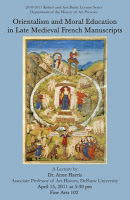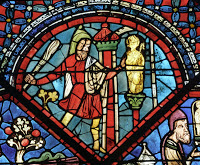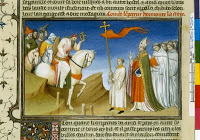Medieval History
Wow, and well, it really happened. The lecture of a lifetime happened on Friday, and now there is breathing, much breathing, to be done. I can summarize the talk now: at stake is the visual representation of race in late medieval France. And this critical term, speculative morality, I've come up with to understand the use of the images. The audience liked working with the term during the question and answer period: the idea that the challenge of these images is to provoke the viewers into a moral dilemma: is the Sultan to be trusted after he's revealed his knowledge of Christian iniquities gained through his merchants-spies? Does commerce with his merchants continue after such a revelation? Is it a matter of inference or speculation? These images work with their manuscript texts, they're involved in their geopolitical contexts (the conquests, approaches, and diplomatic alliances of the Muslim Ottoman Turk empire, and, to a lesser extent, the Mongols): there's a rich world to explore here. But I can't say that I still understand the images. Race is not coded by skin color; in some ways ethnicity is a better term that is used a great deal in textual analysis, but what would it mean visually? Some of the distinction is what we would today call cultural, or religious - but neither of those terms can get at the complexity of the simultaneous need to create difference (to justify conquest), and sameness (to justify conversion) - that's too simply put, but these are some of the rubs.
Other rubs: I keenly felt the limitations of being a small liberal arts college person giving a talk to a graduate department at a research university. I am a teacher first and foremost, who sees my work primarily as that of presenting problematic material which will open up questions for discussion. I realize that I don't do much closure and synthesis, big (really big) picture thinking, or critical terminology with any kind of certitude. 20-minute conference papers (which I love to give) are exploratory, lay out new ground, and ask questions. This kind of 45-minute plenary talk felt different (bigger, more conclusive) in its expectations. I.e. - I felt very much in over my head, and struggled for the pertinence of what I was presenting beyond itself. I know what the big picture is (now it's so clear that I can put it at the beginning of a blog post: it's "all about" the visual representation of race in late medieval France), but I felt like my words couldn't make my images speak to it. Part of it is that I don't have full mastery of the images - I'm still in the stage where I'm asking questions instead of coming up with answers. How long will I be in this stage? It feels like it's been years already - but Mac keeps reminding me that this is a big project - and that was the response from the talk, too. There's been great work done on monsters and monstered humans in medieval art, but very little on human-figured counterparts. Actually, it's interesting: the human-figured counterparts _are_ discussed, but in ethnographic terms: in terms of information (what was known? was it correct or incorrect?) instead of ideology (how is this knowledge represented? with what associations?). Does race exist in the Middle Ages? Yes, with all sorts of caveats about ethnicity and the construction of race as a category productive of racism in the 18th century. How is it visible? This is harder to answer - yes, sometimes Saracens are represented as blue monsters, but just as often they are not: they sit and talk and eat and are "just like" Western Christians.
I know what started all of this. It was working on the anti-Semitic (cultic anti-Judaism) images within saint Nicholas windows at Chartres cathedral for my dissertation and first articles. The Iconia play of a treasure owner who beats a statue of saint Nicholas for failing to protect his treasure, only to convert after saint Nicholas, having appeared to and chastised the thieves, restores the treasure to him. The treasure owner is alternately Jewish or Muslim or, in some versions, a Barbarian. At Chartres he's Jewish (it's the hat, the Judenhut, required by medieval sumptuary law as of the 13th century), and it was years ago now that these questions started coming of what is visible, and what is not in perceived difference that is desperately sought to dissolve into sameness and possession.
I've always found this image of the Jewish treasure owner's body enduring a conversion baptism very moving (not the terms used in my dissertation): the way that he draws his left hand up onto his chest, holds on to the rim of the baptismal font with his right. Those gestures have always struck me as elegant yet self-protective, defenses against the heavy power of public ritual. This window is directly above an altar, and associates the ritual of conversion through baptism with the eucharistic ritual performed at the altar below. It nourished the Christian fantasy of Jewish conversion: the relentless desire to possess Jewish knowledge, the Jewish past, Jewish place - think of the desire for Jerusalem and all that it contained (Crusades, post-Crusades, constructions, so much - my goodness, still today).
And so now to try to understand the gesture of the Khan bowing before the cross - tipping his crown to it. It's hard sometimes to not dismiss the entire medieval Christian project as hopelessly naïve (really? show enough images of Muslims and Jews and Mongols converting to Christianity and they will come?). And I would, except that, of course, the repercussions are anything but: the brutalization of Muslims and Jews in the Middle ages still clamors for history and explanation. (more work to be done concerning military campaigns against the Mongols - I only know about the zealous missionaries who went). I can't yet pithily say what is happening in this image besides the Christian fantasy of conversion - but I know that in late medieval France, the image is intersecting with new commercial interests (let's not forget why the Marco Polo brothers went East), a geopolitical scene complicated by a French-Ottoman alliance, and a newly justified practice we now call colonialism. I also know that I want to intersect it with the philosophy of speculative materialism, the longing that surrounds the genre of letter-writing (lots of envoys and missives here), and the marvelous objects that are images themselves (to be touched, possessed, felt possessed by).
Wow again! I've been thinking all day of writing about what's happened since the Burke lecture - and yet, no, there's still mulling to be done. I only realize now how utterly all-consuming it had become. And it was a full day: lunch with graduate students, tour of the Lilly Rare Books Library, two wonderful hours with a brilliant graduate student poring over manuscripts that had been brought out for our perusal (yes, marvelous, marvelous objects), the talk itself (I'm usually not nervous but, geez, this time I was), and then a lovely dinner afterwards with talk of Istanbul in 1983, Ravenna and its bishops and churches, and the pleasures and torments of writing. Every minute was quite vivid and intense - but if I were to recount every minute, the horizon scanning and the navel gazing would become one and the same. So I will spare us the details and just let my tremulous gratitude for it all remain.
It's now been two days of re-emergence into my little family - running all around with the kids (while Mac was in Cincinnati with students) during a wonderful, exuberant day that culminated into something as outrageously spectacular as a Japanese steak house. Eleanor was unexpectedly and utterly terrified at the dramatic blazes of fire. I tried to distract her by pointing out a young woman in a floor-length dress bedecked with glistening jewels as a princess, only to be told (solemnly) by Iris that "princesses are extinct." It was beautiful today, and Mac planted raspberry bushes and Oliver and I played a game together and worked on his book report, and the girls watched our favorite French movie, Panique au Village. I was swept up in tremendous nostalgia for Brittany today - wanting to be there just so badly, to really breathe.
- Fort Hood, Murder, And Islam
I don't have too much to say about this whole event, especially since nobody really knows anything about Maj. Hasan's motives at this time. They will, however, get to talk to him eventually. There's a lot of speculation, a lot...
- Recitations
Troubadour casket from Vannes, in BrittanyWe have an "S" (for speaking) requirement where I teach, and long ago I decided to make "Love and War in Medieval Art and Literature" an "S" class. I've never had the courage to call the class what it...
- Beauty, Fantasy, Difference
Bosch, Epiphany, 1500, the PradoThere are more papers, more events, more bureaucracies, more of everything that needs to be swept away for just a few minutes. Balthasar has been on my mind since Tuesday, when we entered the third theoretical framework...
- La Dolce Vita
Oliver at Beit SheanElation! Joy! and Glee! I am in D.C. in the home of my nephew, and tomorrow stretches out luxuriously with ideas and controversies and really smart, adventurous people. Today's talk to dear faculty colleagues was intense:...
- Always Almost Jerusalem
12th c. map of JerusalemMost unexpectedly, I have had a couple of hours alone in the house while one kid is at a friend's house, and the other two are with Mac and friends at a museum. The mind reels! Laundry called, then piano, but now, just a few...
Medieval History
Breathe
 |
| The poster from The Talk |
Other rubs: I keenly felt the limitations of being a small liberal arts college person giving a talk to a graduate department at a research university. I am a teacher first and foremost, who sees my work primarily as that of presenting problematic material which will open up questions for discussion. I realize that I don't do much closure and synthesis, big (really big) picture thinking, or critical terminology with any kind of certitude. 20-minute conference papers (which I love to give) are exploratory, lay out new ground, and ask questions. This kind of 45-minute plenary talk felt different (bigger, more conclusive) in its expectations. I.e. - I felt very much in over my head, and struggled for the pertinence of what I was presenting beyond itself. I know what the big picture is (now it's so clear that I can put it at the beginning of a blog post: it's "all about" the visual representation of race in late medieval France), but I felt like my words couldn't make my images speak to it. Part of it is that I don't have full mastery of the images - I'm still in the stage where I'm asking questions instead of coming up with answers. How long will I be in this stage? It feels like it's been years already - but Mac keeps reminding me that this is a big project - and that was the response from the talk, too. There's been great work done on monsters and monstered humans in medieval art, but very little on human-figured counterparts. Actually, it's interesting: the human-figured counterparts _are_ discussed, but in ethnographic terms: in terms of information (what was known? was it correct or incorrect?) instead of ideology (how is this knowledge represented? with what associations?). Does race exist in the Middle Ages? Yes, with all sorts of caveats about ethnicity and the construction of race as a category productive of racism in the 18th century. How is it visible? This is harder to answer - yes, sometimes Saracens are represented as blue monsters, but just as often they are not: they sit and talk and eat and are "just like" Western Christians.
 | |
| Saint Nicholas panel from Chartres |
 |
| Saint Nicholas panel from Chartres |
 |
| Khan bowing before the cross |
Wow again! I've been thinking all day of writing about what's happened since the Burke lecture - and yet, no, there's still mulling to be done. I only realize now how utterly all-consuming it had become. And it was a full day: lunch with graduate students, tour of the Lilly Rare Books Library, two wonderful hours with a brilliant graduate student poring over manuscripts that had been brought out for our perusal (yes, marvelous, marvelous objects), the talk itself (I'm usually not nervous but, geez, this time I was), and then a lovely dinner afterwards with talk of Istanbul in 1983, Ravenna and its bishops and churches, and the pleasures and torments of writing. Every minute was quite vivid and intense - but if I were to recount every minute, the horizon scanning and the navel gazing would become one and the same. So I will spare us the details and just let my tremulous gratitude for it all remain.
It's now been two days of re-emergence into my little family - running all around with the kids (while Mac was in Cincinnati with students) during a wonderful, exuberant day that culminated into something as outrageously spectacular as a Japanese steak house. Eleanor was unexpectedly and utterly terrified at the dramatic blazes of fire. I tried to distract her by pointing out a young woman in a floor-length dress bedecked with glistening jewels as a princess, only to be told (solemnly) by Iris that "princesses are extinct." It was beautiful today, and Mac planted raspberry bushes and Oliver and I played a game together and worked on his book report, and the girls watched our favorite French movie, Panique au Village. I was swept up in tremendous nostalgia for Brittany today - wanting to be there just so badly, to really breathe.
- Fort Hood, Murder, And Islam
I don't have too much to say about this whole event, especially since nobody really knows anything about Maj. Hasan's motives at this time. They will, however, get to talk to him eventually. There's a lot of speculation, a lot...
- Recitations
Troubadour casket from Vannes, in BrittanyWe have an "S" (for speaking) requirement where I teach, and long ago I decided to make "Love and War in Medieval Art and Literature" an "S" class. I've never had the courage to call the class what it...
- Beauty, Fantasy, Difference
Bosch, Epiphany, 1500, the PradoThere are more papers, more events, more bureaucracies, more of everything that needs to be swept away for just a few minutes. Balthasar has been on my mind since Tuesday, when we entered the third theoretical framework...
- La Dolce Vita
Oliver at Beit SheanElation! Joy! and Glee! I am in D.C. in the home of my nephew, and tomorrow stretches out luxuriously with ideas and controversies and really smart, adventurous people. Today's talk to dear faculty colleagues was intense:...
- Always Almost Jerusalem
12th c. map of JerusalemMost unexpectedly, I have had a couple of hours alone in the house while one kid is at a friend's house, and the other two are with Mac and friends at a museum. The mind reels! Laundry called, then piano, but now, just a few...
